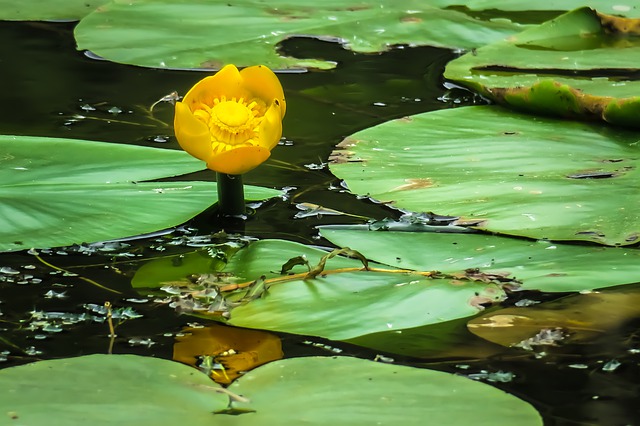 |  |  |    |    |
 |  |
The yellow Water-lily is a hydrophyte that lives in water. The plant is perennial with up to 2-3 m thick, greenish on top and pale bottom root, which sticks to the ground. In addition, the rhizome is covered with many scars from previously fallen leaf stalks and flower stalks. The leaves are leathery, entire-edged, heart-shaped and elliptical, with a depression at the base, the leaves float on the surface of the water. The leaves are green on the surface, quite large, more than 15 cm long. Petioles of floating leaves 50-350 cm long. The surface of the leaf never remains wet thanks to a thick wax coating. The new leaves are covered with mucus, which is secreted by special glands - trichomes. The physiological significance of mucus has not yet been clarified. Moreover, it is not the outside of the leaf that is covered with mucus, but the diaphragms that pass through the air-containing veins, which do not come into contact with water, but with the atmosphere inside the leaf stalks.
Flowers actinomorphic, bisexual, large, about 4 cm in diameter, solitary on long flower stalks (up to 5 m long). Calyx bright yellow, functionally replacing strongly reduced, small, scaly petals.
Fruit - sinocarp berry-like multi-leaf, no larger than 10 cm in diameter, in shape corresponds to a cup. The seeds are small, with a small germ immersed in a weakly developed endosperm, under which there is a strong starchy perisperm. The plant blooms in June-August, in the southern regions it also blooms in May. Flowering lasts for a couple of hours. Lepe has an observable protogyny, which ensures the pollination of flowers. Apart from the bright color and aroma that attract pollinating insects, there is also nectar on the rudamentous petals of the abaxial side.
Various parts of the Yellow Water-lily are used for medicinal purposes - root and roots, flowers, leaves and seeds. Basically, rhizomes and roots are used, which are collected in summer, during flowering and fruit ripening, or in autumn. The rhizomes are collected in not too deep water bodies by cutting the underside of the roots; in deep water bodies the whole plant is recovered and the rhizomes are separated. The rhizomes are cleaned from the leaf stalks and roots, rinsed, cut into rounds (1-1.5 cm) and after wrapping, dried in well-ventilated and shaded places, spreading them in a thin layer. It is also allowed to dry in forced dryers, not exceeding a temperature of 50-60C. The dried root has a weak aroma and a bitter taste, it is stored in well-ventilated, special racks. Storage up to 2 years.
The chemical composition of Yellow Water-lily has been insufficiently studied. Sulphur-containing alkaloids - nufaridines, among which the main ones are nuflein, thiobinufaridine, deoxynufaridine, allothiobinufaridine, as well as tanides, sucrose 5-6%, metarabinic acid, starch 20%, tannins 2.3%, bitter substances, resins, sitosterol, stigmasterin, phenolic carbonates, vitamin C and carotene.
The flowers contain alkaloids and glycosides; in seeds 44-45% starch, 6.7% tannins, sitosterol and nymphalin; in the leaves - ellagotannin, luteolin, caffeic acid, ferulic acid, sinapic acid and p-coumaric acid.
Medicinal significance
The pharmacological properties of yellow Water-lily are directly related to their chemical composition. The specific pharmacological activity of the plant is related to its alkaloids, such as lutenurin, which has been well studied experimentally.
Lutenurin is a broad-spectrum antimicrobial preparation that suppresses the development of gram-positive, including antibiotic-resistant bacteria, as well as spore-forming and acid-resistant bacteria and pathogenic fungi, including candida , and also has activity against trichomonads. The bacteriostatic effect of Lutenurin is more pronounced in a weakly alkaline environment. In addition, luteneurin has a strong spermatocidal effect.
Yellow Water-lily also has many other medicinal properties - anti-inflammatory, sedative, pain-relieving, fungicidal, sleep-inducing, anti-tumor, etc. It should be mentioned that all parts of the plant also contain a unique alkaloid nymphaline, which has many valuable properties, being able to affect people psychoactively.
In folk medicine, Yellow Water-lily is widely used as an anti-inflammatory, spasmolytic, sedative, sleep-inducing, pain-relieving, anti-fever, anti-tumor, hypotensive, bleeding-stopping, sedative agent.
It is important to remember that Yellow Water-lily are poisonous plants and their use must be justified and caution must be observed. Doses should be small. In folk medicine, rhizomes and root decoctions are used to treat inflammation of the kidneys (pyelonephritis), inflammation of the bladder and urinary tract (cystitis), diseases of the digestive tract, pneumonia, pulmonary tuberculosis, rheumatism, as well as to increase potency in men and prevent frigidity in women. The rhizomes are recommended for the treatment of stomach spasms, gastritis, bleeding, gout, whooping cough, as well as to reduce arterial blood pressure.
Yellow Water-lily is a finding in people who have problems with immunity, after major operations and chemotherapy. A water infusion of fresh flowers has a sleep-promoting and calming effect in case of excessive sexual arousal and night pollution. On the other hand, the seeds of the Yellow Water-lily have a sleep-promoting and calming effect, but they are also widely used to increase sexual activity.
In European folk medicine, all plant parts are used in the form of water infusions to treat malignant tumors. It is also used as a natural contraceptive.
Preparations of Yellow Water-lily are useful in the treatment of uterine bleeding, uterine prolapse, fever, colds, bronchitis, nocturnal enuresis (especially in children), insomnia and poor sleep.
Yellow Water-lily is also widely used in home cosmetology and dermatology. A decoction of rhizomes and roots is used to strengthen hair and in case of seborrhea (with the addition of hops), inflammation and various skin diseases.
Fresh, crushed leaves and flowers are placed on inflammation to reduce inflammatory processes. Flower arrangements are used in baths and for washing, in case of skin inflammation and as a pain reliever in case of rheumatic, gouty and joint pain.
